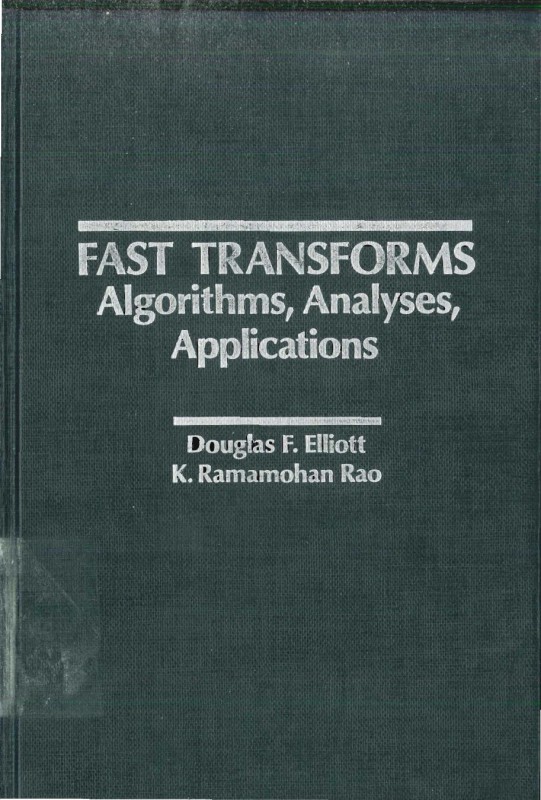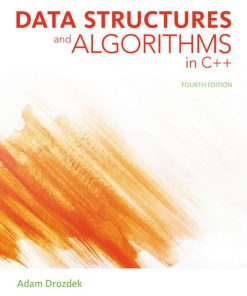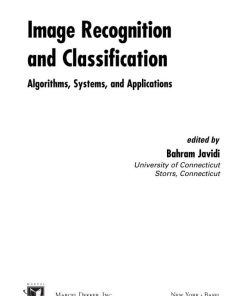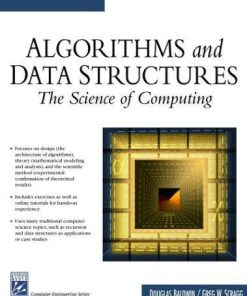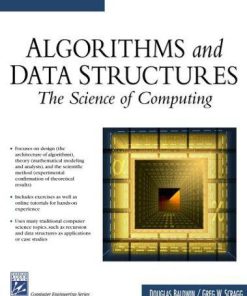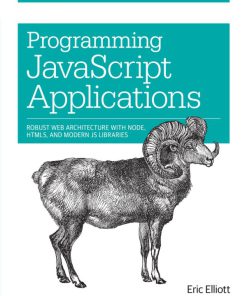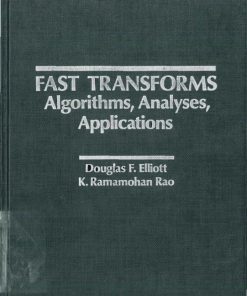Fast Transforms Algorithms Analyses Applications 1st Edition by Douglas Elliott, Ramamohan Rao ISBN 9780080918068 0080918069
$50.00 Original price was: $50.00.$25.00Current price is: $25.00.
Authors:Douglas F. Elliott; K. Ramamohan Rao , Series:IT & Computer [306] , Tags:Mathematics; General; Mathematical Analysis , Author sort:Elliott, Douglas F. & Rao, K. Ramamohan , Ids:Google; 9780122370809 , Languages:Languages:eng , Published:Published:Mar 1982 , Publisher:Elsevier Science , Comments:Comments:This book has grown from notes used by the authors to instruct fast transform classes. One class was sponsored by the Training Department of Rockwell International, and another was sponsored by the Department of Electrical Engineering of The University of Texas at Arlington. Some of the material was also used in a short course sponsored by the University of Southern California. The authors are indebted to their students for motivating the writing of this book and for suggestions to improve it.
Fast Transforms Algorithms Analyses Applications 1st Edition by Douglas Elliott, Ramamohan Rao – Ebook PDF Instant Download/Delivery. 9780080918068 ,0080918069
Full download Fast Transforms Algorithms Analyses Applications 1st Edition after payment
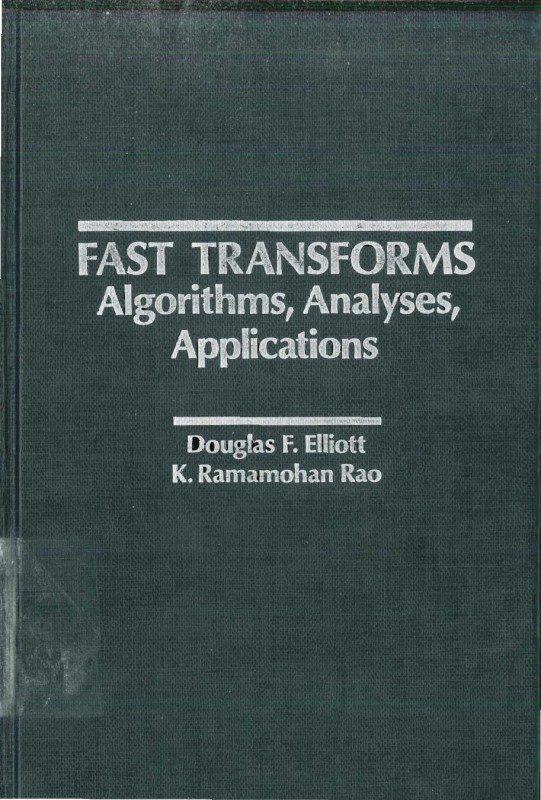
Product details:
ISBN 10: 0080918069
ISBN 13: 9780080918068
Author: Douglas Elliott, Ramamohan Rao
Fast Transforms Algorithms Analyses Applications 1st Edition Table of contents:
Chapter 1. Introduction
1.0 Transform Domain Representations
1.1 Fast Transform Algorithms
1.2 Fast Transform Analyses
1.3 Fast Transform Applications
1.4 Organization of the Book
Chapter 2. Fourier Series and the Fourier Transform
2.0 Introduction
2.1 Fourier Series with Real Coefficients
2.2 Fourier Series with Complex Coefficients
2.3 Existence of Fourier Series
2.4 The Fourier Transform
2.5 Some Fourier Transforms and Transform Pairs
2.6 Applications of Convolution
2.7 Table of Fourier Transform Properties
2.8 Summary
Problems
Chapter 3. Discrete Fourier Transforms
3.0 Introduction
3.1 DFT Derivation
3.2 Periodic Property of the DFT
3.3 Folding Property for Discrete Time Systems with Real Inputs
3.4 Aliased Signals
3.5 Generating kn Tables for the DFT
3.6 DFT Matrix Representation
3.7 DFT Inversion—the IDFT
3.8 The DFT and IDFT—Unitary Matrices
3.9 Factorization of WE
3.10 Shorthand Notation
3.11 Table of DFT Properties
3.12 Summary
Problems
Chapter 4. Fast Fourier Transform Algorithms
4.0 Introduction
4.1 Power-of-2 FFT Algorithms
4.2 Matrix Representation of a Power-of-2 FFT
4.3 Bit Reversal to Obtain Frequency Ordered Outputs
4.4 Arithmetic Operations for a Power-of-2 FFT
4.5 Digit Reversal for Mixed Radix Transforms
4.6 More FFTs by Means of Matrix Transpose
4.7 More FFTs by Means of Matrix Inversion—the IFFT
4.8 Still More FFTs by Means of Factored Identity Matrix
4.9 Summary
Problems
Chapter 5. FFT Algorithms That Reduce Multiplications
5.0 Introduction
5.1 Results from Number Theory
5.2 Properties of Polynomials
5.3 Convolution Evaluation
5.4 Circular Convolution
5.5 Evaluation of Circular Convolution through the CRT
5.6 Computation of Small Ν DFT Algorithms
5.7 Matrix Representation of Small Ν DFTs
5.8 Kronecker Product Expansions
5.9 The Good FFT Algorithm
5.10 The Winograd Fourier Transform Algorithm
5.11 Multidimensional Processing
5.12 Multidimensional Convolution by Polynomial Transforms
5.13 Still More FFTs by Means of Polynomial Transforms
5.14 Comparison of Algorithms
5.15 Summary
Problems
Chapter 6. DFT Filter Shapes and Shaping
6.0 Introduction
6.1 DFT Filter Response
6.2 Impact of the DFT Filter Response
6.3 Changing the DFT Filter Shape
6.4 Triangular Weighting
6.5 Hanning Weighting and Hanning Window
6.6 Proportional Filters
6.7 Summary of Weightings and Windows
6.8 Shaped Filter Performance
6.9 Summary
Problems
Chapter 7. Spectral Analysis Using the FFT
7.0 Introduction
7.1 Analog and Digital Systems for Spectral Analysis
7.2 Complex Demodulation and More Efficient Use of the FFT
7.3 Spectral Relationships
7.4 Digital Filter Mechanizations
7.5 Simplifications of FIR Filters
7.6 Demodulator Mechanizations
7.7 Octave Spectral Analysis
7.8 Dynamic Range
7.9 Summary
Problems
Chapter 8. Walsh-Hadamard Transforms
8.0 Introduction
8.1 Rademacher Functions
8.2 Properties of Walsh Functions
8.3 Walsh or Sequency Ordered Transform (WHT)w
8.4 Hadamard or Natural Ordered Transform (WHT)h
8.5 Paley or Dyadic Ordered Transform (WHT)p
8.6 Cal-Sal Ordered Transform (WHT)cs
8.7 WHT Generation Using Bilinear Forms
8.8 Shift Invariant Power Spectra
8.9 Multidimensional WHT
8.10 Summary
Problems
Chapter 9. The Generalized Transform
9.0 Introduction
9.1 Generalized Transform Definition
9.2 Exponent Generation
9.3 Basis Function Frequency
9.4 Average Value of the Basis Functions
9.5 Orthonormality of the Basis Functions
9.6 Linearity Property of the Continuous Transform
9.7 Inversion of the Continuous Transform
9.8 Shifting Theorem for the Continuous Transform
9.9 Generalized Convolution
9.10 Limiting Transform
9.11 Discrete Transforms
9.12 Circular Shift Invariant Power Spectra
9.13 Summary
Problems
Chapter 10. Discrete Orthogonal Transforms
10.0 Introduction
10.1 Classification of Discrete Orthogonal Transforms
10.2 More Generalized Transforms
10.3 Generalized Power Spectra
10.4 Generalized Phase or Position Spectra
10.5 Modified Generalized Discrete Transform
10.6 (MGT), Power Spectra
10.7 The Optimal Transform: Karhunen-Loeve
10.8 Discrete Cosine Transform
10.9 Slant Transform
10.10 Haar Transform
10.11 Rationalized Haar Transform
10.12 Rapid Transform
10.13 Summary
Problems
Chapter 11. Number Theoretic Transforms
11.0 Introduction
11.1 Number Theoretic Transforms
11.2 Modulo Arithmetic
11.3 DFT Structure
11.4 Fermat Number Transform
11.5 Mersenne Number Transform
11.6 Rader Transform
11.7 Complex Fermat Number Transform
11.8 Complex Mersenne Number Transform
11.9 Pseudo-Fermat Number Transform
11.10 Complex Pseudo-Fermat Number Transform
11.11 Pseudo-Mersenne Number Transform
11.12 Relative Evaluation of the NTT
11.13 Summary
Problems
Appendix:
Direct or Kronecker Product of Matrices
Bit Reversal
Circular or Periodic Shift
Dyadic Translation or Dyadic Shift
modulo or mod
Gray Code
Correlation
Convolution
Special Matrices
Dyadic or Paley Ordering of a Sequence
References
Index
People also search for Fast Transforms Algorithms Analyses Applications 1st Edition:
application of algorithm in real life
ram model for algorithm analysis
fast fourier transform and convolution algorithms
fast fourier transform algorithm explained

